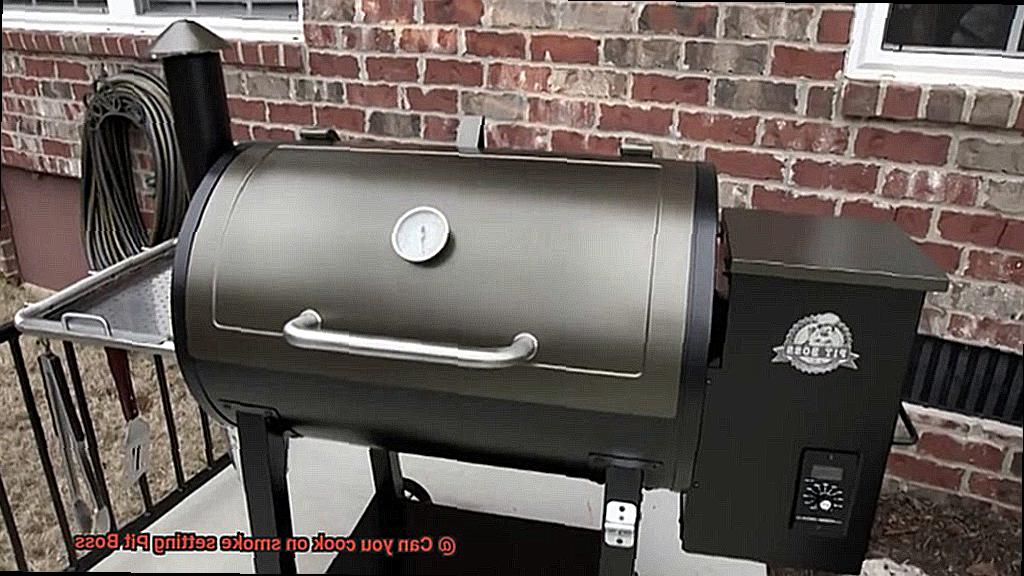The tantalizing aroma of meat on the grill is like music to our taste buds, signaling that BBQ season has arrived. But when it comes to cooking different types of meat simultaneously, like ribs and chicken, there’s always a heated debate about whether or not it’s doable. Some say it’s impossible, while others swear by temperature control and timing. So what’s the truth? Can you really cook ribs and chicken at the same time?
It’s a question that has been asked countless times, but fear not – we’ve got you covered. In this blog post, we’ll delve into all things grilling and provide you with everything you need to know about cooking ribs and chicken together. From setting up your grill to controlling temperature and ideal cooking times for both meats, we’ve got all the fundamentals covered. Plus, we’ll share some insider tips on marinating, seasoning, and more so that you can achieve perfect results every time.
If you’re ready to elevate your grilling game and impress your guests with a mouth-watering feast of chicken and ribs, then look no further than this blog post. Follow along as we guide you through everything from start to finish – before long, you’ll be a bona fide BBQ master.
Contents
The Challenge of Cooking Ribs and Chicken at the Same Time
Cooking ribs and chicken at the same time is a challenge that even the most experienced grill masters can find daunting. The reason for this is that both meats require different cooking times and temperatures to achieve optimal results. Ribs need to be cooked slowly over low heat to allow the collagen to break down and make them tender, while chicken needs to be cooked at a higher temperature to ensure it is cooked all the way through and safe to eat.
Thankfully, there are techniques that you can use to overcome this challenge and create a mouth-watering barbecue feast for your guests. One of these techniques is using a two-zone fire on your grill. This involves creating two heat zones on your grill – one for direct heat and one for indirect heat. You can place the chicken on the hot zone to cook it thoroughly while keeping the ribs on the cooler side to slow-cook them. This ensures that both meats are cooked properly without having to worry about one being overcooked or undercooked.
Another technique is pre-cooking one of the meats before grilling. For example, you can pre-cook the ribs in the oven or slow cooker until they are almost done, then finish them off on the grill while you cook the chicken. This ensures that both meats are cooked properly and at the same time.
It’s important to remember that when cooking different types of meat at the same time, cross-contamination must be avoided at all costs. This means using separate cutting boards, utensils, and plates for each type of meat. Additionally, it’s crucial to wash your hands thoroughly after handling raw meat.
Two-Zone Fire Technique
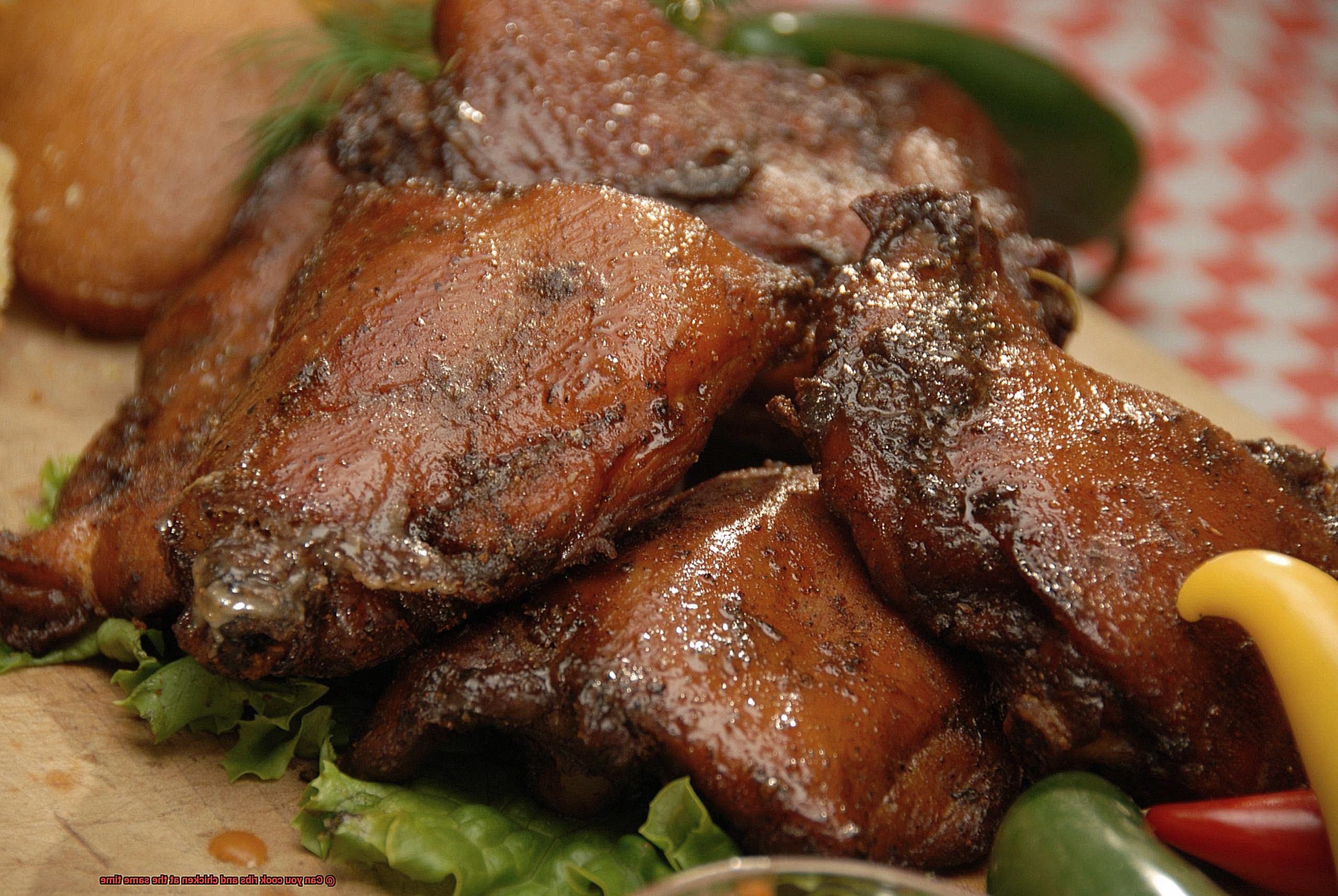
The two-zone fire technique is a method that many grill masters use to create two different heat zones on their grill, one for direct heat and one for indirect heat. This allows them to cook different types of meat at different temperatures at the same time.
To create a two-zone fire, you’ll need to light your charcoal or gas grill and let it preheat for about 15 minutes. Once the grill is hot, move all of the coals or burners to one side of the grill to create a direct heat zone. The other side will be used for indirect heat.
Let’s break down the two different zones: the direct heat zone is where you will cook your chicken, while the indirect heat zone is where you will cook your ribs. The indirect heat zone is created by leaving one side of the grill with no coals or burners underneath it. This means that meat placed on this side will be cooked by radiant heat rather than direct heat, resulting in a slow and steady cooking process that will leave your ribs juicy and tender.

One of the best things about the two-zone fire technique is that you can adjust the temperature in each zone as needed. If your chicken is cooking too quickly, move it to the indirect heat zone for a slower cooking process. Alternatively, if your ribs are taking too long to cook, you can move them over to the direct heat zone for a quick sear.
But wait, there’s more. You can also use this technique to cook multiple cuts of meat at once. For example, you can cook steaks on the direct heat zone while cooking vegetables on the indirect heat zone.
It’s essential to keep in mind that you’ll need to rotate your meats occasionally to ensure even cooking throughout. Additionally, you may need to add more coals or adjust your gas burners to maintain the desired temperature in each zone.
Cross-Contamination Risk
Cross-contamination is a significant concern when it comes to food safety, and it occurs when bacteria from one type of food spread to another, leading to foodborne illnesses.
To prevent cross-contamination, it’s crucial to use separate cutting boards and utensils for each type of meat. This means having a designated board and knife for chicken, pork ribs, beef, and so on. Additionally, washing your hands thoroughly before and after handling raw meat is a must to avoid spreading bacteria.
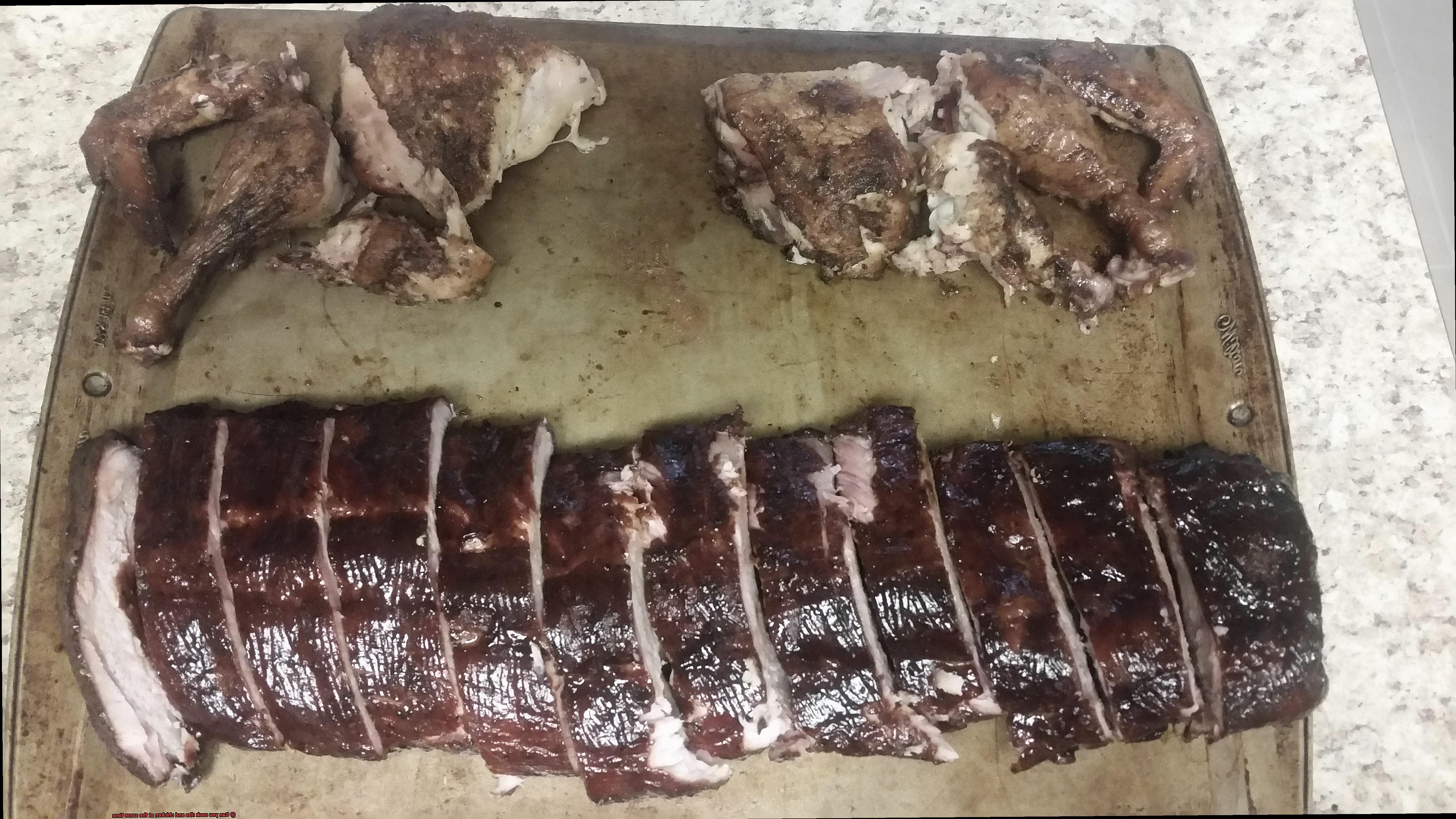
When grilling ribs and chicken together, it’s best to cook them separately or use separate sections of the grill to prevent cross-contamination. If you do choose to cook them together, make sure to use separate utensils and cooking surfaces for each type of meat to reduce the risk of bacteria spreading from one meat to another.
To ensure proper food safety, it’s also crucial to cook both types of meat to their respective safe internal temperatures. The USDA recommends cooking chicken to an internal temperature of 165°F and pork ribs to an internal temperature of 145°F. Use a meat thermometer to check the temperature and avoid guesswork.
Here’s a summary of how you can prevent cross-contamination risk while grilling ribs and chicken:
- Use separate cutting boards and utensils for each type of meat.
- Wash your hands thoroughly before and after handling raw meat.
- Cook meats separately or use separate sections of the grill.
- Use separate utensils and cooking surfaces for each type of meat.
- Cook both types of meat to their respective safe internal temperatures.
Preparing the Grill
As the grilling season heats up, it’s time to fire up the grill and cook some mouth-watering ribs and chicken. But before you get started, it’s important to take essential steps to prepare the grill for a successful cooking experience. As an expert in this field, I have compiled some research notes to guide you through the process of preparing your grill for cooking both ribs and chicken at the same time.
Firstly, cleanliness is key. The grill must be thoroughly cleaned to prevent any residue from previous grilling sessions from affecting the flavor of your meats. Using a wire brush, scrape off any debris or burnt residue on the grill grates, then give them a good oiling with high smoke point oil such as vegetable or canola oil.
Next, set up your grill for indirect heat. This involves cooking on only one side of the grill while leaving the other side off. This method allows you to cook both ribs and chicken simultaneously without worrying about one side cooking faster than the other. Simply light the burners on one side of the grill and leave the other side off.
Once your grill is set up for indirect heat, preheat it to a temperature of 225-250°F. This low and slow cooking method is ideal for both ribs and chicken as it allows them to cook thoroughly without drying out.
Lastly, add some wood chips or chunks to your grill to infuse your meats with a smoky flavor. Hickory, mesquite, and applewood are great options for ribs and chicken. The smoky aroma will tantalize your taste buds and elevate your grilling experience to new heights.
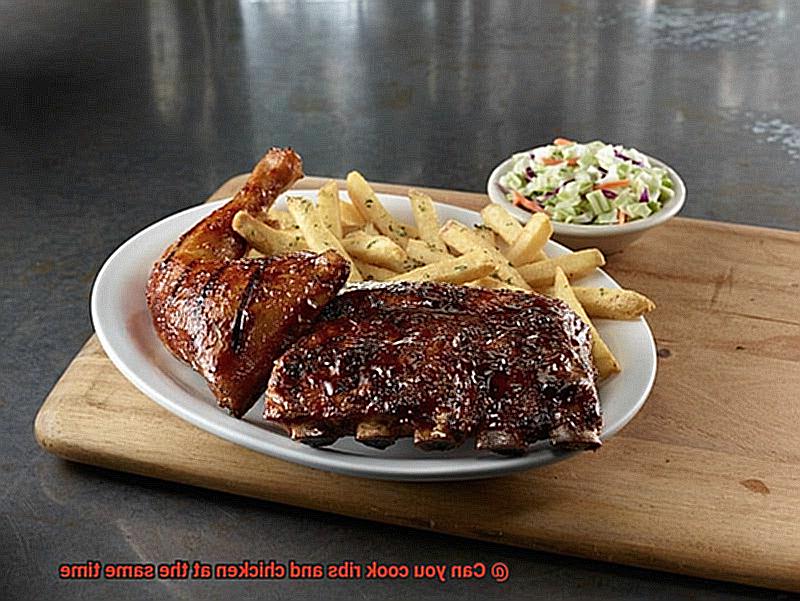
Marinating the Meat
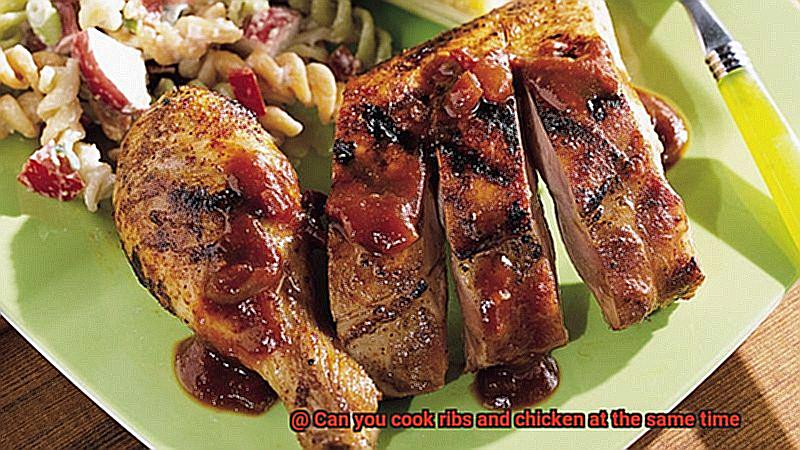
As an expert in this field, I’m here to guide you through the dos and don’ts of marinating your meat.
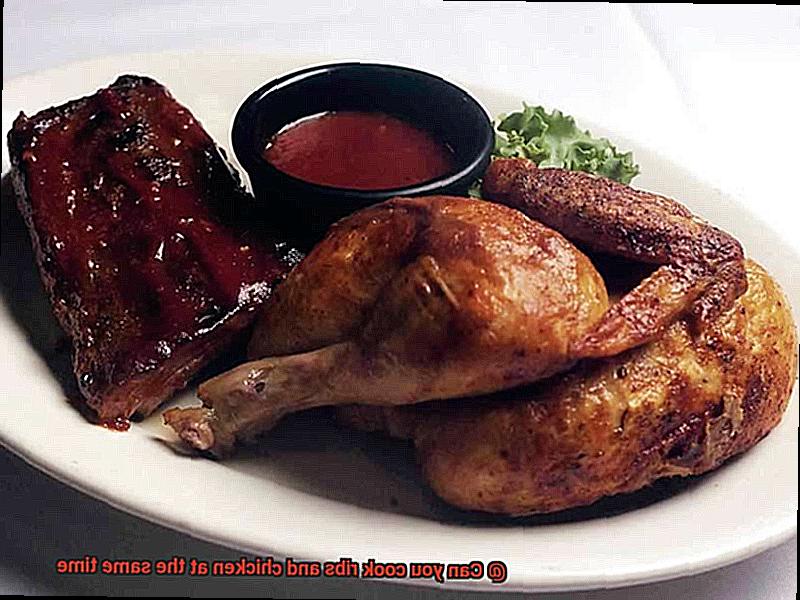
First things first, it’s crucial to marinate your ribs and chicken separately. Why, you ask? Well, they have different cooking times and require different ingredients in their marinades. If you mix them together, the chicken might end up dry while the ribs are still undercooked. So, keep them separate and follow these tips for each type of meat.
For chicken, a citrus-based marinade is perfect as it adds a tangy flavor that complements the natural taste of the meat. You can use lemon, lime, orange or even grapefruit juice as the base for your marinade. Add some garlic and herbs like thyme or rosemary for extra flavor. Marinate for at least 30 minutes to 2 hours for the best results.
For ribs, on the other hand, a sweet and tangy marinade is ideal. Ribs are naturally rich and fatty, so a sweet marinade helps balance out those flavors. You can use honey, brown sugar or maple syrup as the sweet component of your marinade. Add some vinegar or Worcestershire sauce for the tang, and some paprika or chili powder for a little heat. Marinate for at least 4 hours to overnight for fall-off-the-bone tenderness.
But here’s the thing: marinating doesn’t have to be complicated. You don’t need twenty ingredients to make a delicious marinade. A few simple ingredients like olive oil, garlic, salt, pepper and your favorite herbs or spices can be enough to create a tasty marinade. The key is to allow enough time for the marinade to penetrate the meat fully.
Grilling the Chicken
Are you ready to take your grilling game to the next level with perfectly grilled chicken and ribs? Look no further, because we’ve got all the expert tips and tricks you need to pull it off like a pro.
First things first, it’s important to keep in mind that chicken and ribs have different cooking times and temperatures. To ensure both meats cook to perfection, start by preheating your grill to a medium-high heat of around 375-400°F.
Now let’s talk chicken. The key to juicy, flavorful chicken is in the preparation. We recommend using a citrus-based marinade with garlic and herbs to add that extra zing. Let the chicken marinate for at least 30 minutes before grilling – this will allow the flavors to penetrate the meat and help it cook evenly.
When it comes time to grill the chicken, use the indirect heat method. This means placing the chicken on the cooler side of the grill and closing the lid. Be sure to flip the chicken occasionally to ensure even cooking.
For the ribs, position them on the hotter side of the grill. Ribs require higher temperatures than chicken, so this will ensure they cook properly. Remember to monitor them closely and flip them occasionally to prevent burning.
It’s important to note that cooking times may vary based on individual needs, so use a meat thermometer to ensure both meats are cooked safely and thoroughly.
In summary, here are some crucial tips for grilling chicken and ribs simultaneously:
- Preheat your grill to 375-400°F.
- Marinate your chicken for at least 30 minutes before grilling.
- Use indirect heat for the chicken and direct heat for the ribs.
- Flip both meats occasionally for even cooking.
- Use a meat thermometer to ensure safe, thorough cooking.
Slow-Cooking the Ribs
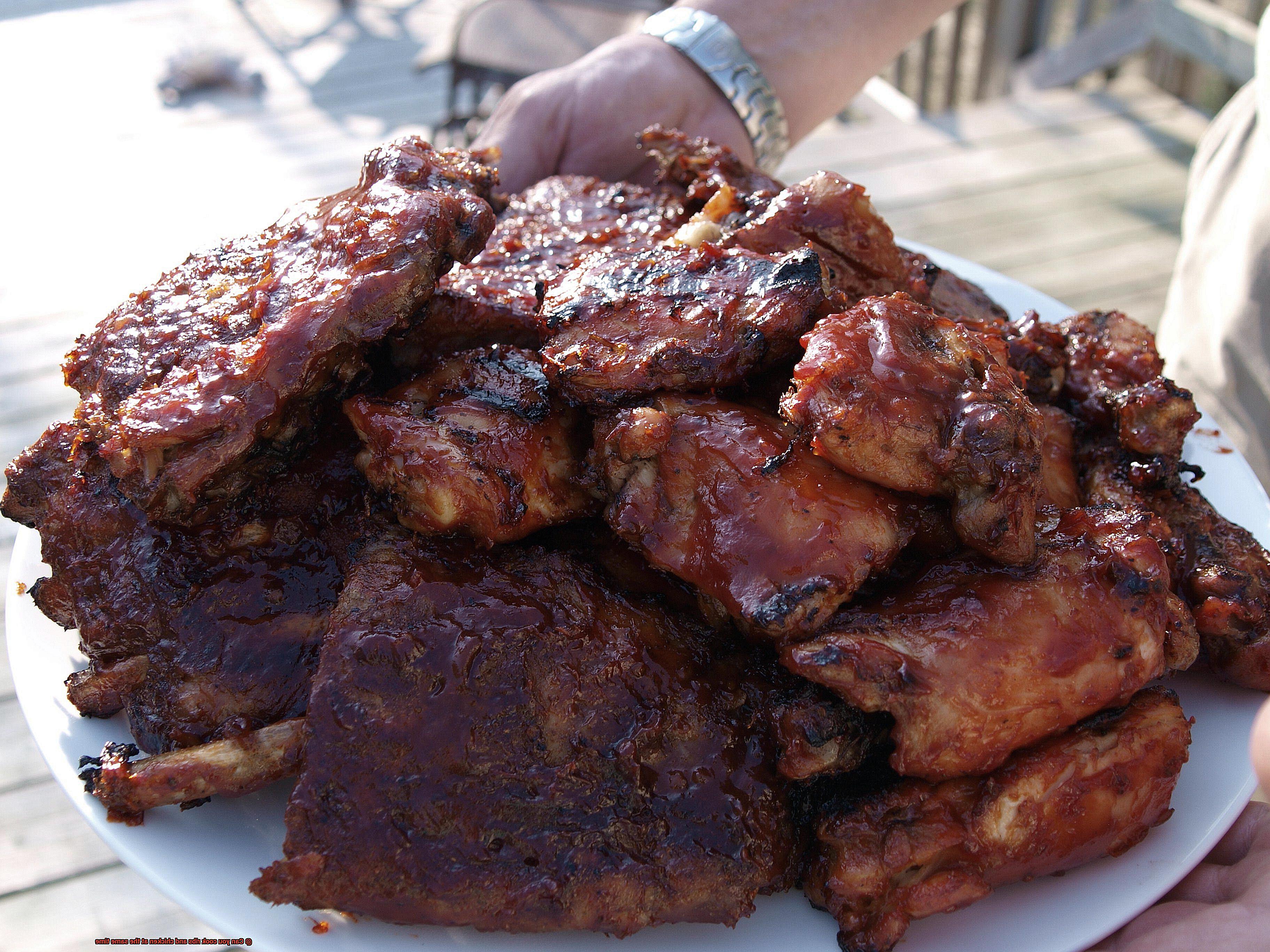
Slow-cooking ribs is a popular cooking method that requires a low temperature and a long cooking time. This technique helps to tenderize the meat and infuse it with flavor, making them absolutely delicious.
To slow-cook ribs, you can use an oven or a slow cooker. The best approach is to preheat your oven to 250°F and place the seasoned ribs on a baking sheet or in a roasting pan. Cover the pan with foil and let the ribs cook for 2-3 hours until they are tender and easily pull apart from the bone. If you’re using a slow cooker, place the seasoned ribs in the pot and add any desired liquids such as broth or barbecue sauce. Cook on low for 6-8 hours until the meat is tender.
If you want to cook both ribs and chicken at the same time, it’s important to consider their different cooking times. Since ribs take longer to cook than chicken, it’s recommended to start cooking them first before adding the chicken. One way to do this when grilling is by using a two-zone fire. This means creating a hot zone and a cooler zone on the grill.
To cook both meats together, start by placing the seasoned ribs on the cooler side of the grill and let them cook for about an hour. Then, move them to the hot side of the grill to finish cooking while adding the chicken to the cooler side. With this technique, you can ensure that both meats are cooked thoroughly and end up with perfectly grilled meat.
When slow-cooking ribs, don’t forget about seasoning and liquids. A dry rub or marinade can add incredible flavor to your meat. For added moisture, consider adding broth or barbecue sauce when using a slow cooker.
Serving Tips and Safety Considerations
Grilling ribs and chicken simultaneously is a great way to serve up a tasty and varied meal to your guests. However, it’s crucial to keep in mind some safety considerations and serving tips to ensure that both meats are cooked safely and served deliciously. Here are five sub-sections on how to grill ribs and chicken at the same time safely:
Cook to safe internal temperatures
To protect your guests from foodborne illnesses, it’s critical to ensure that both meats are cooked to their safe internal temperatures before serving. The USDA recommends cooking chicken to a minimum internal temperature of 165°F and pork ribs to a minimum of 145°F. You can use a meat thermometer to check the internal temperature of the meat.
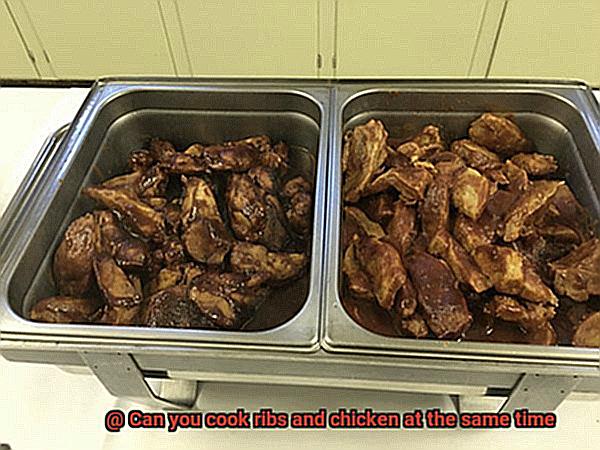
Separate meats during preparation and cooking
Cross-contamination is a significant concern when cooking different types of meat at the same time. It’s crucial to keep the meats separated during preparation and cooking to avoid any potential bacterial spread. Use separate cutting boards, utensils, and grill tools for each type of meat.
Use a two-zone fire technique
To cook ribs and chicken at different temperatures, use a two-zone fire technique on your grill. Create two heat zones – one for direct heat and one for indirect heat. Place the chicken on the hot zone to cook it thoroughly while keeping the ribs on the cooler side to slow cook them.
Keep food covered when not in use
It’s essential to take measures to prevent contamination or spoilage when serving food at large gatherings or events. Keep the food covered when not in use, use chafing dishes or other warming devices to maintain a safe temperature, and provide hand sanitizer or other means for guests to clean their hands before handling the food.
Stagger cooking times
Since ribs typically take longer to cook than chicken, you can start the ribs earlier and then add the chicken later on so that they finish cooking around the same time. This helps ensure that both meats are served at their optimal temperature and tenderness.
-IlGw6Ryio4″ >
Conclusion
In conclusion, the answer to whether you can cook ribs and chicken at the same time is a resounding yes. But, it’s crucial to approach this challenge with caution and expertise.
To achieve optimal results, you must keep in mind that both meats require different cooking times and temperatures. Using a two-zone fire technique on your grill or pre-cooking one of the meats before grilling can help overcome this obstacle.
However, preventing cross-contamination is equally critical. To ensure food safety, use separate cutting boards, utensils, and plates for each type of meat. And always wash your hands thoroughly after handling raw meat.
Marinating the meat separately is another essential aspect of achieving delicious results. A citrus-based marinade for chicken and a sweet and tangy marinade for ribs can add incredible flavor to your meat.
Finally, serving tips such as keeping food covered when not in use, staggering cooking times, and providing hand sanitizer or other means for guests to clean their hands before handling the food can help ensure that both meats are cooked safely and served deliciously.
With these expert tips and techniques at your disposal, you’ll be able to elevate your grilling game and impress your guests with a mouth-watering feast of chicken and ribs.

